
03 Jul Top Tips on How to Play Your Best Tennis Game
Recently, we interviewed Suzie Freeman, one of the leading clinicians who keep tennis players in top shape, and got some really useful advice.
What is your experience treating tennis players?
I picked up recreational tennis in my late 40s after not playing since High School. Tennis is a very social game, so once other players heard I was a Physical Therapist, they began to come to me with their tennis-associated injuries. This gave me a lot of experience in treating both acutely, as well as in the rehab setting with more stubborn injuries. As an “older” player myself, I also experienced a variety of aches and pains, which gave me firsthand experience as to what treatments really worked and what didn’t.
What are the most common injuries you see with recreational tennis players?
For the upper body, of course, lateral epicondylopathy (aka “tennis elbow”) is very common, as is shoulder pain. Rotator cuff tendinopathy can be seen in both male and female players, though a number of women can get frozen shoulders. For the lower body, I see anterior knee pain, Achilles’ tendinopathy, and plantar fasciopathy. The professional players tend to suffer from injuries related to the high forces of their games and the season’s intensity. For the recreational players, injuries often come down to poor technique or inadequate training regimens. This can be a good thing because many of these biomechanical issues can be corrected, allowing the athlete to continue to play well into their “later” years.
Do you have any tips regarding injury prevention for the recreational tennis player?
Off-court physical training can make or break a tennis player’s performance. However, it is especially critical for the recreational player who is 35 years or older. That point in life appears to be a time where our bodies seem less-forgiving to physical stresses like start-and-stop running on cement and explosive movements with our arms. Off-court training can be broken down into 3 categories: cardiovascular, strength training, and flexibility.
Cardiovascular training is always a good idea, as we all tend to lose our form as fatigue happens. Loss of form and control can definitely be a precursor to injury. One can make cardio work more tennis-specific by adding interval training: short bursts of increased speed and/or resistance, interspersed with prolonged moderate work. I believe the “best” cardio training is whatever prolonged activity a person doesn’t mind doing. One can use any of the machines at a health club, or just take a brisk walk outdoors and try to include hills in the route.
That leaves strength training and flexibility. Are they equally important?
Strength and flexibility are both important. However, I realize that tennis players have only so much time and motivation to perform exercise outside of the game. In my practice, I have concluded that in general, most women need to put more emphasis on strength training, and most men benefit from a focus on flexibility.
In terms of upper body injuries (especially the shoulder), I see that male recreational players often derive most of their power from their shoulders and upper arms, which can lead to over-use of the rotator cuff. If a male player is able to hit the ball utilizing proper trunk and scapular motion, this will help to unload their rotator cuff. Look up your favorite player online: how much does he rotate his trunk before he hits the ball? Is that how you look on the court? Or does your chest face the net for most of the game? Here’s a quick test for trunk mobility: Stand with your arms out sideways (shoulder height), feet apart, wider than your shoulders, but with your toes turned in. Start facing a wall so that your trunk and hips are parallel, or in-line with the wall. Now, rotate your trunk to the right as far as you can. Can you rotate far enough so that your left arm is now perpendicular to the wall? Now, try to rotate your neck to the left: is your face directed squarely at the wall?
See the end of this interview for a series of off-court stretching exercises that address common areas of tightness. These stretches are for both male and female players.
And the ladies?
Stretching is still important for the women players. In my practice, however, I have found that women might need to put more emphasis on strength training. A number of upper body and neck injuries can arise from the poor stability of the shoulder blades. An easy way to train that would be to do plank-type exercises. With tennis, our arms are more commonly outstretched. So, I like to do planks with the elbows straight, weight-bearing on the palms vs. weight-bearing on the forearms with the elbows tucked into our sides. When performing plank exercises, it is critical to brace the abdominals, keep the shoulder blades pulled down, and maintain good cervical posture so that our chins are pulled in and back.
In terms of pre-match warming up, I believe it’s better to do your flexibility and strengthening work outside of match play. Some studies show a temporary decrease in strength after you stretch a muscle, and you certainly don’t want to go into a match with muscle fatigue from lifting weights. See below for instructions on several exercises that can be done right on the court as a pre-match warm-up. Also, please be sure to take the time to do the traditional tennis warm-up before you play. Even a 5-minute warm-up can go a long way to prevent injuries.
How has Astym treatment impacted your tennis clients?
Bringing in Astym treatment has been a huge benefit for my tennis clients. I can now resolve many injuries that were previously considered “unresolvable”. Also, their recovery time is cut in half – or more. On average, my “tennis elbow” clients are back on the court in 2 weeks, with competitive play at 3 weeks. I see a few players who “pop” their calf muscle. From the day of injury to back to playing full-force is two weeks. And these are middle age players.
Astym therapy also helps me find the source of the problem. Most people with tennis elbow point to the “bone” as the source of their pain. However, with Astym treatment, I can find different muscles around the elbow that are showing signs of dysfunction. For example, when it hurts lower on the epicondyle, it can often be related to not changing your grip when performing a slice. What about pain in the central part of the bone? I have seen that occur when the grip is too forceful…or sometimes it could be choice of strings. Pain more in the fleshy part of the arm? I often see that in players who strike the ball at serve with a slightly flexed elbow.
Has Astym therapy helped you as a player?
All the time. I have managed to consistently play 3-4 times per week with a stiff, arthritic shoulder.
What should injured players do if their therapist doesn’t understand tennis?
One of the great things about being a Certified Astym Provider is that you have a means of connecting with other therapists who specialize in a certain sport. In most cases, the standard Astym treatment is all most people need, but for unusual cases, outside help is available.
Check out the Astym-Certified Provider Directory on the Astym website and find a certified clinician in your area who can get you back on the court and help to keep you there! If you can’t find an Astym-Certified Provider near you, have one of your local physical therapists visit www.astym.com to sign up for certification training.
Clinician Interviewed: Suzie Freeman, MPT, OCS, Astym Cert
Post Warm-up/Work-out Tennis Stretches
For the Dynamic Stretches: take each position to a comfortable end range, pause, and then stretch the opposite side.
For the Static Stretches: hold a comfortable end-range position for 30 seconds, making sure to breathe normally. Repeat 2-3 times on each side.
Lying on Back:
Dynamic Hip Crossover
Starting with arms out in “T” position, feet flat on the floor, and knees bent and together brace your abdominal muscles and roll both knees to the right side slowly, controlling the lowering of your legs, letting the weight of your legs pull to end range. Repeat 2-3 times on each side.

Dynamic Leg Overs
Starting with arms out in “T” position and legs straight on the floor, engage abdominals. Lift left leg up as high and straight as you can. Then, cross it over your body towards the floor. Contract your abdominals and return to starting position. Repeat 2-3 times on each side.


Lying on side:
Static Pretzel Stretch
Laying on your side flex hips to 90 degrees and hold the top ankle with the hand on the same side. Slightly roll pelvis inwards to prevent rounding of the lower back. Take the heel of the weight-bearing leg and place it above the kneecap of the top knee. Use that heel to push the top knee back and towards the table. You should feel a stretch in the quadriceps or the lateral thigh.
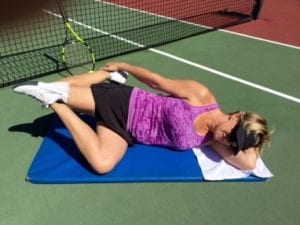
Static Thoracolumbar rotation stretch
Start on your side, lying with the hips stacked and flexed to 90 degrees. Rotate your trunk to face the ceiling and abduct your shoulder to 150 degrees, allowing it to rest on the floor. Stabilize your knees with the opposite hand.

Lying on Stomach:
Dynamic Scorpions
Start with arms out in “T” position and legs straight on the floor. Flex the left knee to 90 degrees and lift the leg up and over towards the opposite shoulder, not allowing the left thigh to contact the right leg. Pause and return to starting position. Repeat 2-3 times on each side.


Dynamic Press-ups
With your hands under your shoulders, press up one vertebral level at a time while keeping low back and buttocks relaxed. Go as far as you comfortably can, pause, then return to starting position. Repeat 2-3 times.

From Quadruped:
Modified Prayer Stretch
Sitting back onto your chest, round your back, tuck in your belly button and pull in your chin to your chest. Allow your palms to face the ceiling. Hold this pose to feel a stretch in your lats (upper back).

Static Pigeon Stretch
Starting on hands and knees, lift one leg up and over the opposite ankle, sliding foot down and back. Keep hips squared up until you feel a stretch on the outside of the hip on your bent leg. Hold for 30 seconds to one minute, and repeat on the opposite side.


From a Plank:
Dynamic Sprinter’s Stretch
From a plank position, walk hands backward, moving into a pike position. Bend one knee to achieve a stretch through the opposite calf. Repeat 2-3 times each side.
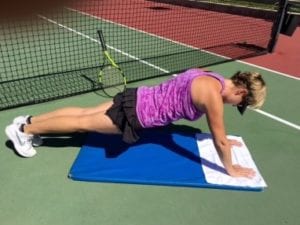

Static Deep Lunge Stretch
Walk hands forward to assume a plank position. Move one foot forward and next to hand on the same side. Pause, then return to the plank position and repeat on the opposite side. Repeat 2-3 times each side.

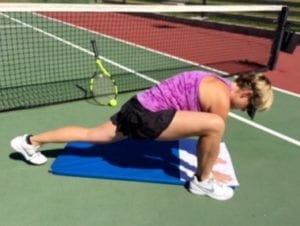
On Court Warm-Up
Tall march with knee hug
Maintain vertical posture and focus on balance. Raise up on toes as the knee is pulled to the chest.

Lunge steps
These can be performed with the rear leg either dropping straight to the ground (first photo) or with it stretched behind and the knee maintained in extension (second photo).
In both cases, make sure to keep your torso perpendicular to the ground. Avoid rounding your back.
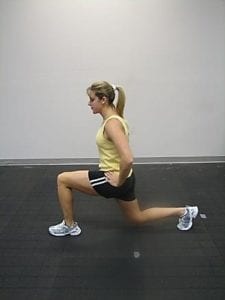

Lateral lunge steps
While maintaining a “sternum up” posture in the torso, weight is shifted first to the right and then the left followed by a pivot which leaves you facing the opposite direction and the shift is repeated.
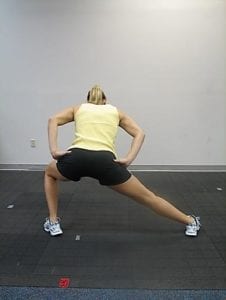

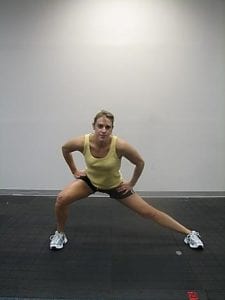

Soldier march/skip
Lift right leg to outstretched left hand while maintaining an upright posture. As you warm up, increase the velocity and height of the kick, progressing up onto the toes of your standing leg. Alternate feet for 5 repetitions on each side.
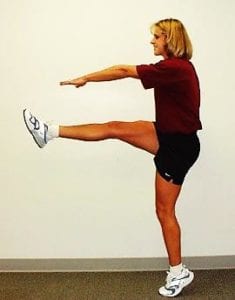
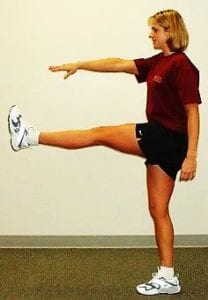
Sprinter’s stretch
Kneel on the right knee with your left leg in front of you with your foot flat on the ground. Place hands on the floor to support yourself. Straighten left hip and knee slowly, keeping foot flat. Hold for a count of 1-2 seconds, lower, and repeat five times in a slow pumping motion. Repeat stretch with left foot turned out, and then with left foot turned in. Perform the same stretch with right leg in front.
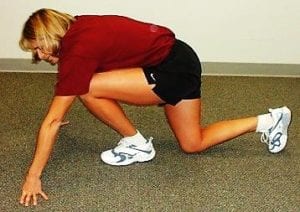



Heel cord stretch/Big toe rocks
In pike position with both hands on the floor, lift one foot to the heel of opposite foot. Next, lift heel off the floor to achieve a toe extension, then slowly lower back to the floor giving pressure in a downward direction with the opposite foot from behind. Repeat 3 times to each side.
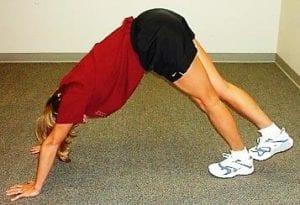
Spiderman
Lunge forward onto right leg, bringing the right arm to the inside of the right leg and lower hips toward the floor until you feel a stretch in the left hip flexor; pause and then reach forward with opposite leg – like Spiderman – to the same position with the opposite leg. Repeat 3 times on each side.



Twister
Starting with arms straight and to the side in a “T” position, bend forward at the hips keeping back straight similar to the setup position in golf. Keeping knees pointed straight ahead, rotate your trunk and swing arms from side-to-side, letting the weight and momentum of your arms pull you to end range. Then, slowly start to raise up to an upright position while maintaining arm swinging motion. From an upright position, continue arm swing but now bend elbows to 90 degrees. Then, slowly straighten arms to overhead position while continuing arm swing motion. Slowly lower arms through each position back to the starting position—the whole time maintaining arm swing motion.

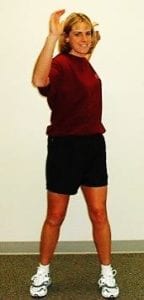

Hug world/Hug self
Wrap arms around trunk by crossing them in front while in a forward bent/back straight position (similar to golf set-up position) emphasizing spreading shoulder blades apart. Then, while coming to the upright position, squeeze shoulder blades together as if hugging the world; then back to the “hug self” position, etc Repeat 3 times.
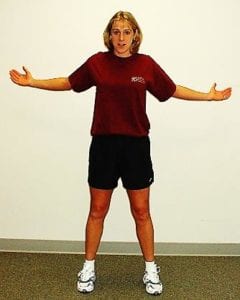
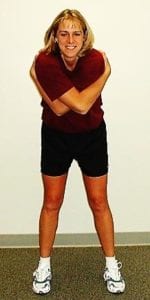
Dynamic flexibility handout provided by Performance Dynamics, Inc. Program developed from the contributions of Amy Goddard, PT, DPT, OCS, CSCS and John Zanas, PT, CSCS, PES




